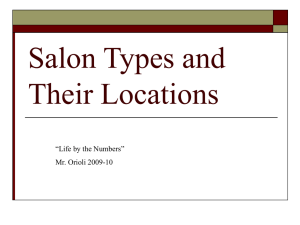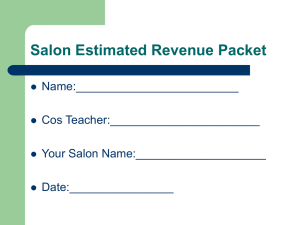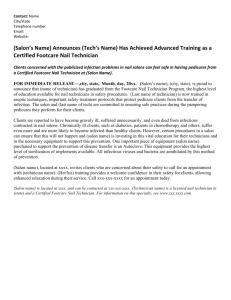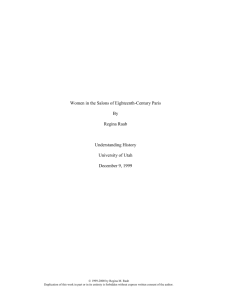2013年1月12日托福写作真题回忆
advertisement
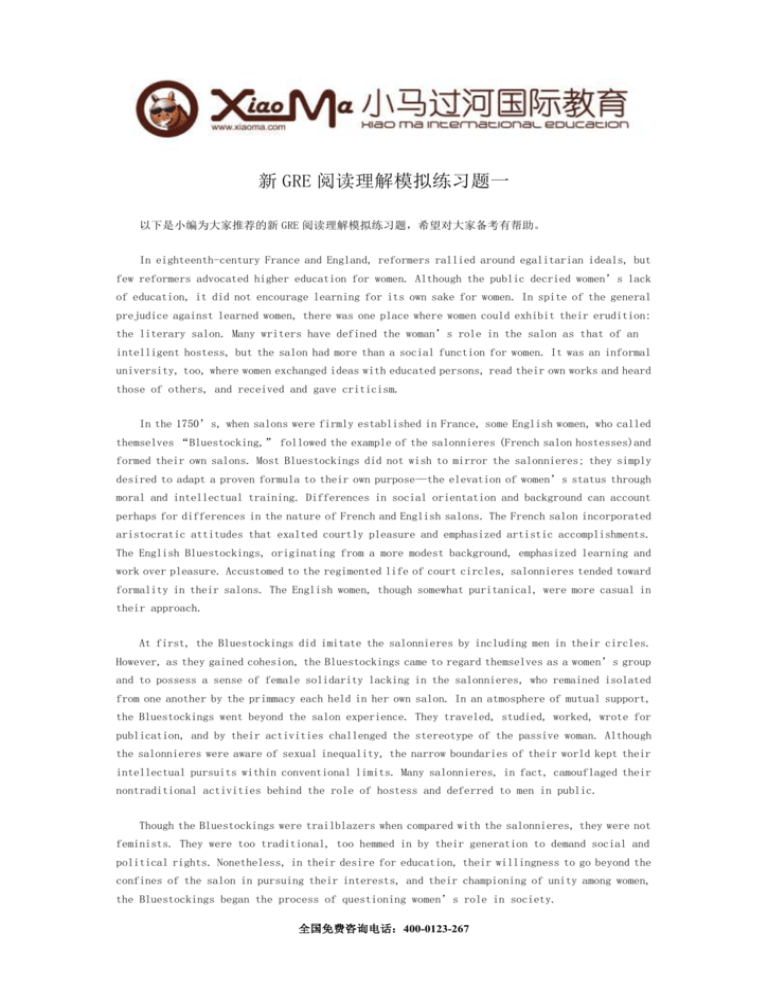
新 GRE 阅读理解模拟练习题一 以下是小编为大家推荐的新 GRE 阅读理解模拟练习题,希望对大家备考有帮助。 In eighteenth-century France and England, reformers rallied around egalitarian ideals, but few reformers advocated higher education for women. Although the public decried women’s lack of education, it did not encourage learning for its own sake for women. In spite of the general prejudice against learned women, there was one place where women could exhibit their erudition: the literary salon. Many writers have defined the woman’s role in the salon as that of an intelligent hostess, but the salon had more than a social function for women. It was an informal university, too, where women exchanged ideas with educated persons, read their own works and heard those of others, and received and gave criticism. In the 1750’s, when salons were firmly established in France, some English women, who called themselves “Bluestocking,” followed the example of the salonnieres (French salon hostesses)and formed their own salons. Most Bluestockings did not wish to mirror the salonnieres; they simply desired to adapt a proven formula to their own purpose—the elevation of women’s status through moral and intellectual training. Differences in social orientation and background can account perhaps for differences in the nature of French and English salons. The French salon incorporated aristocratic attitudes that exalted courtly pleasure and emphasized artistic accomplishments. The English Bluestockings, originating from a more modest background, emphasized learning and work over pleasure. Accustomed to the regimented life of court circles, salonnieres tended toward formality in their salons. The English women, though somewhat puritanical, were more casual in their approach. At first, the Bluestockings did imitate the salonnieres by including men in their circles. However, as they gained cohesion, the Bluestockings came to regard themselves as a women’s group and to possess a sense of female solidarity lacking in the salonnieres, who remained isolated from one another by the primmacy each held in her own salon. In an atmosphere of mutual support, the Bluestockings went beyond the salon experience. They traveled, studied, worked, wrote for publication, and by their activities challenged the stereotype of the passive woman. Although the salonnieres were aware of sexual inequality, the narrow boundaries of their world kept their intellectual pursuits within conventional limits. Many salonnieres, in fact, camouflaged their nontraditional activities behind the role of hostess and deferred to men in public. Though the Bluestockings were trailblazers when compared with the salonnieres, they were not feminists. They were too traditional, too hemmed in by their generation to demand social and political rights. Nonetheless, in their desire for education, their willingness to go beyond the confines of the salon in pursuing their interests, and their championing of unity among women, the Bluestockings began the process of questioning women’s role in society. 全国免费咨询电话:400-0123-267 17. Which of the following best states the central idea of the passage? (A)The establishment of literary salons was a response to reformers’ demands for social rights for women. (B)Literary salons were originally intended to be a meeting ground for intellectuals of both sexes, but eventually became social gatherings with little educational value. (C)In England, as in France, the general prejudice against higher education for women limited women’s function in literary salons to a primarily social one. (D)The literary salons provided a sounding board for French and English women who called for access to all the educational institutions in their societies on an equal basis with men. (E)For women, who did not have access to higher education as men did, literary salons provided an alternate route to learning and a challenge to some of society’s basic assumptions about women. 18. According to the passage, a significant distinction between the salonnieres and Bluestockings was in the way each group regarded which of the following? (A)The value of acquiring knowledge (B)The role of pleasure in the activities of the literary salon (C)The desirability of a complete break with societal traditions (D)The inclusion of women of different backgrounds in the salons (E)The attainment of full social and political equality with men 19. The author refers to differences in social background between salonnieres and Bluestockings in order to do which of the following? (A)Criticize the view that their choices of activities were significantly influenced by male salon members (B)Discuss the reasons why literary salons in France were established before those in England (C)Question the importance of the Bluestockings in shaping public attitudes toward educated women 全国免费咨询电话:400-0123-267 (D)Refute the argument that the French salons had little influence over the direction the English salons took (E)Explain the differences in atmosphere and style in their salons 20. Which of the following statements is most compatible with the principles of the salonnieres as described in the passage? (A)Women should aspire to be not only educated but independent as well. (B)The duty of the educated women is to provide an active political model for less educated women. (C)Devotion to pleasure and art is justified in itself. (D)Substance, rather than form, is the most important consideration in holding a literary salon. (E)Men should be excluded from groups of women’s rights supporters. 21. The passage suggests that the Bluestockings might have had a more significant impact on society if it had not been for which of the following? (A)Competitiveness among their salons (B)Their emphasis on individualism (C)The limited scope of their activities (D)Their acceptance of the French salon as a model for their own salons (E)Their unwillingness to defy aggressively the conventions of their age 22. Which of the following could best be considered a twentieth-century counterpart of an eighteenth century literary salon as it is described in the passage? (A)A social sorority (B)A community center (C)A lecture course on art 全国免费咨询电话:400-0123-267 (D)A humanities study group (E)An association of moral reformers 23. To an assertion that Bluestockings were feminists, the author would most probably respond with which of the following? (A)Admitted uncertainty (B)Qualified disagreement (C)Unquestioning approval (D)Complete indifference (E)Strong disparagement 24. Which of the following titles best describes the content of the passage? (A)Eighteenth-Century Egalitarianism (B)Feminists of the Eighteenth Century (C)Eighteenth-Century Precursors of Feminism (D)Intellectual Life in the Eighteenth Century (E)Female Education Reform in the Eighteenth Century 答案 E B E C E D B C 来源于:小马过河 小马过河资料下载频道,欢迎您来下载! 全国免费咨询电话:400-0123-267 全国免费咨询电话:400-0123-267




